Last weekend I went out of town, which accounts for the lack of recent
blog-posts around here. My boss took me, K, Young B and J as well as two ladies
who are studying Russian at the school to the southern shore of Lake Issyk Kul
for the weekend. We left on Friday night, and drove to the small village of
Kara-Koo (pronounced Kara-Koh), where we had stayed back in February. In case you don't
remember, Kara-Koo is where my boss's husband is from, and where his brothers
and mother still live, and we stayed at their house. We arrived late in the
evening, and after our hosts plied us with tea and fried breads smothered in
jam, we went to sleep.
The next morning, after a hearty Kyrgyz breakfast, we set off for the village
of Barskoon (pronounced Bars-kone), which is located about two hours east of
Kara-Koo. Barskoon is unfortunately known for its close proximity to the Kumtor
gold mine, which in 1998 spilled two tons of cyanide into the Barskoon river,
killing hundreds, injuring thousands and causing the worst pollution event in
Lake Issyk Kul's history. (You can read more about that here.) The Barskoon waterfall is located
halfway up the side of a mountain on the left side of the road, roughly midway
between the village of Barskoon and the Kumtor gold mine.
At the side of the road at the spot where the waterfall first comes into view
is a bust of Yuri Gagarin. Legend has it that as he was being rocketed into
space on the first ever manned spaceflight, Gagarin looked out of his space
capsule and saw this waterfall. Apparently he was so impressed by what he saw,
that after returning to earth, he came to see it on vacation. As such there are
two monuments to Gagarin at this site. One is fairly new and in good condition.
The other, erected by the Soviets, has been thoroughly defaced over the years.
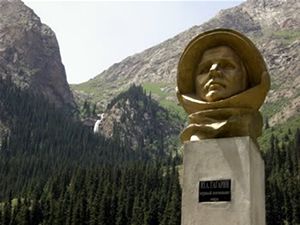
(You can see the waterfall to the left of Gagarin's neck...)
From here we began our hike up into the
mountains. That waterfall might not look all that far up there, but let me tell
you, getting there was strenuous work. There are three main cataracts to this
waterfall, and our first goal was (obviously) the lowest one. While the trek to
the lowest falls is fairly steep, it isn't that great of a distance and it was
certainly well worth the view.
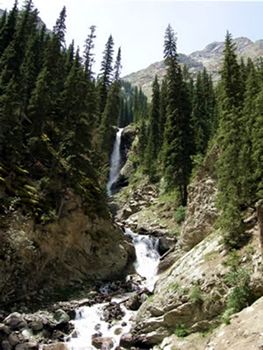
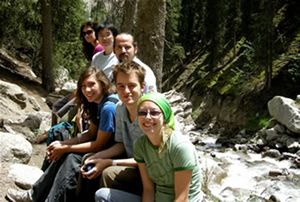
Back to front: The two students, J, K, B, me
After the first cataract, the climb got
considerably steeper, and our pace grew considerably slower. One of the
students didn't make it the whole way to the top, and B, the other student, and
I seriously considered wimping out. However, J and K forged ahead and soon came
back to tell us that we had collapsed a mere five minutes from the view of the
second cataract. So, we dragged our exhausted selves further along the trail to
a pleasant view at the base of the second falls. We didn't try for the third.
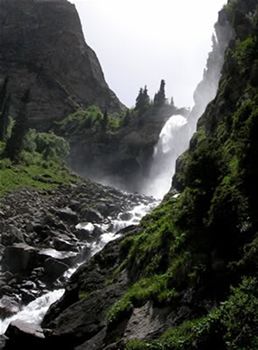
The view was actually quite spectacular, not that you can tell from this photo.
It was difficult to get a decent photo without falling into the river. Plus the
sun was directly behind the falls at that point. Sigh...
After basking in the cool spray of the
falls for a while, we began our trek back down the mountain, which was much
easier than the trek up! We soon arrived back at the base of the mountain,
where our boss and her family had prepared a wonderful picnic for us, with tons
of delicious shashlik and homemade bread. Heaven!
After lunch, we began our drive back to
Kara-Koo. Along the way we stopped twice: once to check out this bizarre thing
under construction at the side of the road. Apparently it's supposed to be a
gigantic tourist resort which allegedly will hold 7000 people and is themed
after the legendary Kyrgyz hero Manas (wikipedia). Currently all that's there is a very long wall painted with curious
murals and topped with bizarre statues. If you peer through the cracks in the
unfinished wall, you will see that there's nothing on the other side. We also
stopped to swim a little bit in the famed Issyk Kul itself. Issyk Kul means
"hot lake" in Kyrgyz, but that water was frigid. As a native Floridian,
I didn't spend much time in there.
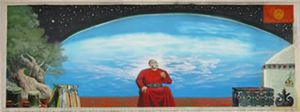
A giant mural to a manaschi, or Manas story teller, at that bizarre
place on the side of the road.
That evening we returned to Kara-Koo for
an evening of scrumptious food and singing (as in February), and we went to bed fairly early.
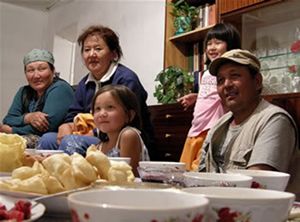
My boss and her in-laws
The next morning, we went first to visit a
local family known in the Kara-Koo vicinity for making yurts and other
traditional handicrafts. The quality of these items was really incredible, and
I would love to buy a yurt (the smallest size, a 4 person yurt, costs $1000),
but not only do I not have an extra grand lying around, but I suspect a yurt
would simply grow moldy in the humidity of the American southeast!
Afterwards, we drove about an hour to Tuz-Kul (which means salt lake in Kyrgyz). The lake, while not as salty as the Dead Sea
was still very salty, and we were incredibly buoyant and left thoroughly
encrusted in salt.
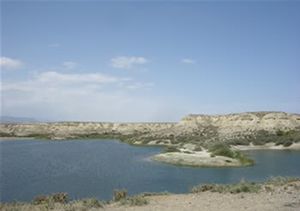
Tuz-Kul
Despite allegedly being a "dead" lake on account of the salt, we
discovered that Tuz-Kul was teeming with these things, which we christened
Primordial Fish Things, but which are apparently Kyrgyz sea-monkeys.
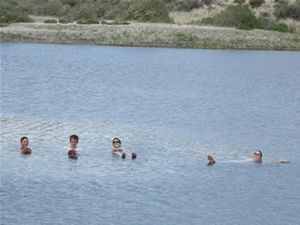
Look! We're floating!
After leaving Tuz-Kul we headed back to
the nearby shore of Issyk Kul in order to wash off the salt. However, while the
comparatively small Tuz Kul had been relatively warm, Issyk Kul was frigid, and
I simply couldn't bring myself to get in. I did take photos though.

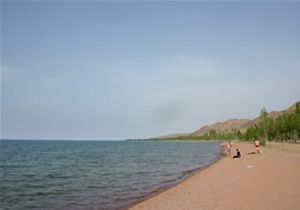
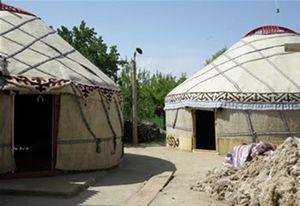
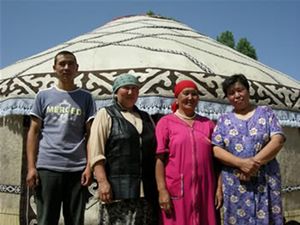
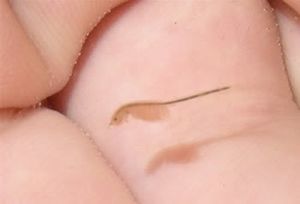
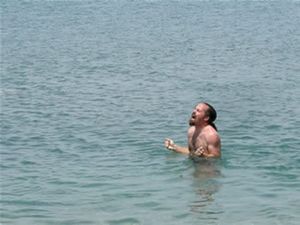
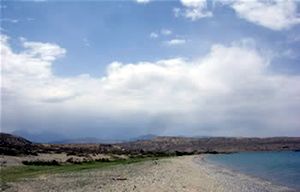
No comments:
Post a Comment